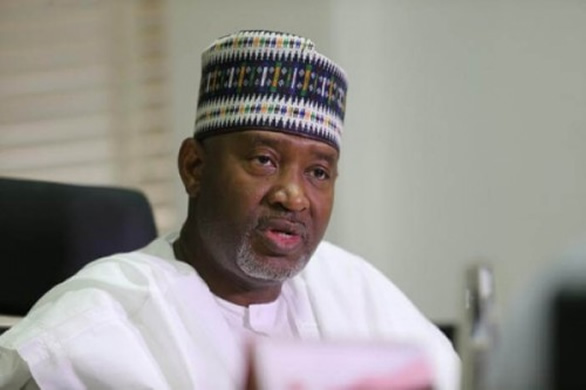In continuation of efforts to fund the N6.4 trillion deficit spending in budget 2022, the Federal Government borrowed N2.2 trillion from local investors in the first quarter of the year, Q1’22, through FGN Bonds, treasury bills and the FGN Savings Bonds.
The amount borrowed however represents an 8.6 per cent decline when compared to N2.4 trillion representing 8.6 per cent, YoY decline from N2.43 trillion sold in Q1’21.
But the FG also paid local investors N827 billion for loans through matured treasury bills, resulting in net borrowing of N1.93 trillion from local investors in Q1’22.
Under the approved Budget 2022, the FG plans to plans to spend N17.1 trillion with projected revenue of N10.7 trillion and fresh borrowing of N6.4 trillion to be financed by foreign borrowings of N2.57 trillion, domestic borrowings of N2.57 trillion, privatization proceeds of N90.7 billion, and multilateral /bi-lateral loan drawdowns of N1.16 trillion.
Thus the net borrowing of N1.93 trillion from local investors in Q1’22 represents 75 per cent of proposed borrowing from local investors in 2022.
The above, when combined with the $1.25 billion (N520 billion) borrowed from foreign investors last week through Eurobonds, indicates an N2.45 trillion increase in the nation’s public debt profile to N42 trillion in Q1’22.
Demand for bonds, TBs up 75% to N4trn
Meanwhile, investors demand for FGN Bonds and Treasury bills, the two main debt instruments of the FG, rose sharply by 75 per cent, year-on-year, YoY, to N4 trillion in the first quarter of the year, Q1’22, from N1.17 trillion in the corresponding quarter of last year, Q4’21.
The sharp increase in investors’ demand is driven by the huge volume of idle cash (excess liquidity) in the financial system, The huge volume of excess liquidity occasioned by the expansionary monetary policy of the Central Bank of Nigeria, CBN, in its quest to sustain the upward momentum in economic growth as reflected in the 3.4 per cent growth in the nation’s Gross Domestic Growth, GDP, in 2021 from 1.8 per cent contraction in 2020.
Among other measures, the CBN increased net liquidity injection into the interbank money market by 110 per cent to N770 billion in the first quarter of the year, Q1’22, from N367 billion in the fourth quarter of last year, Q4’21.
expansionary monetary policy of the Central Bank of Nigeria, CBN, in its quest to sustain the upward momentum in economic growth as reflected in the 3.4 per cent growth in the nation’s Gross Domestic Growth, GDP, in 2021 from 1.8 per cent contraction in 2020.
Among other measures, the CBN increased net liquidity injection into the interbank money market by 110 per cent to N770 billion in the first quarter of the year, Q1’22, from N367 billion in the fourth quarter of last year, Q4’21.
READ ALSO: CBN awards farmers for speedy loan repayment in Cross River
As a result of the sharp increase in net liquidity injection, the average daily opening position of the interbank money market in terms of excess liquidity rose by 73 per cent, QoQ, to N246.84 billion in Q1’22, from N143.42 billion in Q4’21.
The liquidity surge triggered by the above development, resulted in a 75 per cent, YoY upsurge in demand for FGN bonds and NTBs in Q1’22.
Financial Vanguard findings from CBN data and that of the Debt Management Office, DMO, for debt auctions in Q1’22 show that the FG offered N1.17 trillion worth of debt instruments, representing a 21 per cent decline from N1.41 trillion offered in Q1’21.
But the amount of instruments demanded by investors (total subscription) rose by 75 per cent, YoY, to N4.02 trillion in Q1’22 from N2.29 trillion in Q1’21.
Consequently, oversubscription or excess demand for the two instruments rose sharply to 244 per cent in Q1’22 from 63 per cent in Q1’21.
FG borrowings
While the FG increased borrowing through FGN Bonds and FGN Savings Bonds by 15.7 per cent and 21 per cent, YoY respectively in Q1’22, it, however, reduced borrowing through NTBs by 19.7 per cent YoY during the quarter.
Data from the CBN and DMO showed that the FG borrowed N883 billion through FGN Bond auctions in Q1’22, representing 15.7 per cent, YoY increase from N763.2 billion in Q1’21.
While the DMO offered N450 billion worth of FGN Bonds in Q1’22, total subscription (demand) stood at N1.48 trillion.
The DMO, however, sold N764.4 billion and N118.67 billion on competitive and non-competitive basis respectively.
The amount sold comprises N362.76 billion worth of 10-years bonds and N520.31 worth of 20-years bonds.
The FG also borrowed N1.34 trillion through NTBs in Q1’22, representing a 19.7 per cent YoY decline from N1.67 trillion in Q1’21.
While the CBN, on behalf of the FG, offered N715.62 billion worth of NTBs in Q1’22, total subscription (demand) stood at N2.536 trillion, resulting in oversubscription (excess demand) of N254 billion. The apex bank however sold N1.337 trillion worth of bills, comprising N34.3 billion worth of 91-Days NTBs, N66.3 billion worth of 184-Days NTBs and N1.237 trillion worth of N364-Days TBs.
In addition to the above the FG borrowed N334 billion through FGN Savings Bonds in Q1’22 representing 21 per cent YoY increase from N275 billion in Q1’21.
This comprises N2.39 billion borrowed through 3-years savings bonds and N944 million borrowed through 2-years savings bonds.
Banks idle cash with CBN
Meanwhile, the excess liquidity in the interbank money market also triggered a 126 per cent, quarter-on-quarter, QoQ, increase in banks’ deposit of idle cash with the CBN in Q1’22 as well as 122 per cent, QoQ decline in banks’ borrowing from the apex bank.
The CBN has two short term lending windows for banks, namely the Standing Lending Facility (SLF) and Repo lending.
While the CBN lends money to banks through the SLF at interest rate of 100 basis points (bpts) above the Monetary Policy Rate (MPR), it also lends money to banks through Repurchase (Repo) arrangement, which involves the purchase of banks’ securities with the agreement to sell back at a specific date and usually for a higher price.
On the other hand, the CBN accepts deposits from banks through its Standing Deposit Facility (SDF).
Financial Vanguard findings from CBN data show that banks’ borrowing through Repo arrangement dropped sharply by 126 per cent QoQ to N1.77 trillion in Q1’22 from N4.012 trillion in Q4’21.
Similarly, banks’ borrowing through the CBN’s SLF fell sharply by 114 per cent, QoQ, to N877 billion in Q1’22 from N1.87 trillion in Q4’21.
Consequently, banks’ borrowing from the apex bank through the SLF and Repo fell by 122 per cent QoQ to N2.65 trillion in Q1’22 from N5.89 trillion in Q4’21.
However, banks’ deposit of idle cash with the CBN rose sharply by 126 per cent, QoQ, to N1.33 trillion in Q1’22, up from N589.9 billion in Q4’21.







